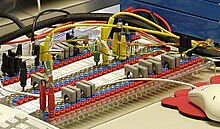Shorting plug
A “ short-circuit plug ” is an electrical jumper with pins . It is a double banana plug ; both pins are at a fixed distance and are electrically connected to one another. Short-circuit plugs are used, among other things, in the field of electrical prototype construction on breadboards and in electrical installations .
To the field of computer technology standard jumper they differ according to the type, size and use: jumpers are designed as a bush, a few millimeters in size and serve the hardware configuration, for example, hard disks .
construction
The contact spacing for standard designs is 19 mm with 4 mm thick contact pins and thus corresponds to the contact spacing for the Euro plugs common in continental Europe . When used in a socket, the short-circuit plug leads to an electrical short circuit and can thus protect against accidental switch-on during work within the framework of the five safety rules of a circuit. Short-circuit plugs are usually used to replace a cable with two banana plugs on breadboards, as shown in the adjacent figure, and thus make a circuit structure clearer.
It is an aid for experimental setups , especially for control panels . Instead of short-circuit plugs, switches or short banana cables could be used, but these would be larger and more expensive; In addition, with short-circuit plugs, it is immediately clear whether a connection exists (short-circuit plug present) or not.
Short-circuit plugs are also used when a voltage of zero is to be ensured at the input of an electrical device (e.g. amplifier) . Please note that a short-circuit plug must not be used at the output (except for outputs with current limiting or short-circuit-proof outputs).

